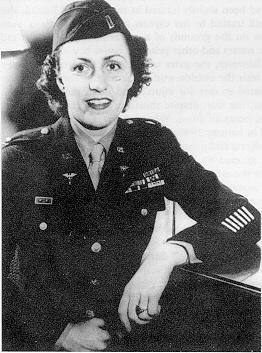WWII Prisoner of War For 3 Years
February 23, 1918 – February 14, 2002
HAMPTON: A CENTURY OF TOWN AND BEACH, 1888-1988
By Peter E. Randall
Chapter 17 — Part 2 — Page 673
World War II

1918 – 2002
A number of Hampton’s military personnel survived battle injuries and imprisonment by the Germans and Japanese. In late May 1944, Union readers learned of Lieutenant Neil J. Coady’s first bombing run over the Ploesti oilfields in Romania; three weeks later, he was reported missing in action and became a prisoner of war, a two-year ordeal that he survived. It was the story of army nurse Rita G. Palmer, however, that captured local attention throughout the conflict. The daughter of Mr. and Mrs. Charles D. Palmer, Rita Palmer completed her nurse’s training in 1939 and joined the Army Nurse Corps in June 1941.
[Photo left: Rita Palmer, army nurse and prisoner of war, March 1945. Left shoulder medals are Bronze Star, Purple Heart, Philippines decoration, Philippines Defense, Asiatic with two stars, Pre-Pearl Harbor. Right shoulder medals are Presidential Citation with two oak leaf clusters, left sleeve with six stripes, each stripe representing six months overseas. Photo courtesy Ansell W. Palmer.]
Sent to the Philippines as a volunteer, she fled Bataan when the Japanese attacked, then was incorrectly reported to be safe in Australia. She was listed as missing in May 1942 after the fall of Corregidor. It was not until November 1943 that her parents and Union readers learned that nurse Palmer had been seen caring for other American prisoners in a Philippines internment camp.
Although she had been slightly injured in the attack on Bataan, she was relatively well treated by her captors at first. The Santo Tomas prison camp was on the grounds of a university, and nearby were stores where the nurses and other prisoners could buy needed items.
Early in 1944, however, the gates were closed and prisoners were denied contact with the outside world. Palmer and the other nurse prisoners continued to care for injured and sick Americans in the camp throughout the war, despite shortages of clothing and ever-diminishing amounts of food.
When she was liberated by the American forces in January 1945, Palmer was weak from hunger and dressed only in shorts and pajama tops.
She returned to Hampton in March and was greeted by 1,000 well-wishers. Lieutenant Palmer, who remained in the army for a while after the war, was one of the most decorated women to serve in the war. The courageous story of the nurses in the prison camp was made into a 1988 television movie.
HAMPTON: A CENTURY OF TOWN AND BEACH, 1888-1988
By Peter E. Randall
Chapter 20 — Sports — Page 732
a Model T-Ford racer built by Palmer, ca. 1935.
[Photo courtesy Ansell Palmer]

{Courtesy of Ansell W. Palmer}

{Courtesy of Ansell W. Palmer}
